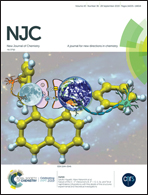Monosubstituted pillar[5]arene functionalized with (amino)phosphonate fragments are “smart” building blocks for constructing nanosized structures with some s- and p-metal cations in the organic phase†
Abstract
Monosubstituted pillar[5]arenes containing a phosphonate fragment were successfully obtained in good yields. It was found that the introduction of bulky fragments containing tetra-coordinated pentavalent phosphorus atoms prevents self-assembly of monosubstituted pillar[5]arenes and the formation of supramolecular polymers. Pillar[5]arenes with phosphonate and 1-aminophosphonate substituents demonstrated recognition towards Na+, K+, Cs+ and Pb2+. Their ability to form complexes with these cations was evaluated by UV spectroscopy. Dynamic light scattering (DLS) revealed the formation of aggregates with K+, Cs+ and Pb2+. It was established that the substituent at the α-carbon atom of the aminophosphonate fragment played a significant role in Pb2+ binding. DLS and transmission electron microscopy revealed that Pb2+-induced aggregation formed particles with a monodisperse distribution of 0.02–0.23 and a hydrodynamic diameter of 58–178 nm.
![Graphical abstract: Monosubstituted pillar[5]arene functionalized with (amino)phosphonate fragments are “smart” building blocks for constructing nanosized structures with some s- and p-metal cations in the organic phase](/en/Image/Get?imageInfo.ImageType=GA&imageInfo.ImageIdentifier.ManuscriptID=C9NJ03539G&imageInfo.ImageIdentifier.Year=2019)


 Please wait while we load your content...
Please wait while we load your content...